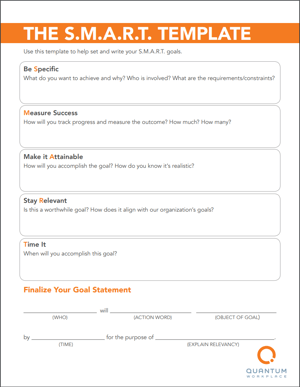8 Tips to Improve Productivity With SMART Goal Setting
Metrics are the lifeblood of every organization. From revenue, profit, and turnover to team productivity, customer satisfaction, and social media impressions—these quantified units reflect how well your organization is operating.
As a manager or leader, you're responsible for influencing a set of those metrics. And one of the most powerful ways to drive performance is through goal setting.
Goals give shape to the chaos. They create direction, clarify expectations, and unite teams around a common purpose. Whether you’re aiming to reduce customer complaints, increase employee retention, or complete more high-impact projects, goals translate metrics into meaningful outcomes.
There are countless frameworks to help set those goals—OKRs, KPIs, MBOs—but one of the most widely used (and misused) is SMART goals. The SMART framework offers a structured way to define, measure, and track progress.
But if you want your goals to do more than check a box—if you want them to evolve with your business and truly drive results—it’s time to make your SMART goals even SMARTER.
In this guide, we’ll explore what SMARTER goals are, break down each component, and share practical tips to help your team set goals that are focused, flexible, and built to succeed.
What are SMART goals?

The SMART framework was first introduced in 1981 by George Doran in a short but influential paper titled “There’s a S.M.A.R.T. Way to Write Management’s Goals and Objectives.” Doran’s goal was simple: cut through the clutter of business jargon and give leaders a clear, memorable way to set effective objectives.
In its original form, SMART stood for:
-
Specific
-
Measurable
-
Assignable
-
Realistic
-
Time-related
Over time, the framework evolved. Today, the most widely accepted version is:
-
Specific: The goal is clear and well-defined.
-
Measurable: You can track progress and outcomes.
-
Achievable: The goal is realistic and attainable.
-
Relevant: It aligns with broader business priorities.
-
Time-bound: There’s a deadline or timeframe attached.
Despite how common SMART goals are, they’ve become a bit of a moving target. A quick online search reveals dozens of alternative words for each letter: motivational, strategic, results-oriented, and more. The core idea remains, but the acronym has taken on different meanings depending on who you ask.
That’s why it’s helpful to return to first principles. At its best, SMART is a tool to help individuals and teams clarify what they’re working toward, why it matters, and how they’ll know they’ve succeeded.
But goal setting doesn’t stop at defining what success looks like. The most effective goals also account for how people interact with them over time. That’s where the SMARTER framework comes in—adding Evaluate and Revise to the mix to create a dynamic, flexible approach to goal achievement.
A Deep Dive on SMARTER Goals
SMARTER goals build on the classic SMART framework by not only clarifying what success looks like, but also guiding how you coach, evaluate, and adjust along the way. Here's how to make each part of SMARTER work harder for you and your team:
S – Specific
Vague goals don’t guide behavior. The more specific you are, the more clearly your team understands what’s expected.
Take this example: A sales manager tells a rep, “Your goal is to make a lot of sales.” But what’s a lot? Ten? Fifty? What kind of sales—product count, revenue, or average deal size?
Now compare that to: “Sell at least 100 products this quarter.” That sets a clear target, with a rationale tied to past performance (e.g., the rep sold 90 products last quarter).
Specific goals answer questions like:
-
What exactly do we want to accomplish?
-
Why is it important?
-
Who’s involved?
-
What constraints or requirements apply?
💡 Manager tip: Set the destination—then let your employee chart the course. Offer coaching and support, but avoid micromanaging every step.
M – Measurable
If you can’t measure it, you can’t manage it. Measurable goals help track progress and determine when a goal has been met.
Back to our example: “Sell 100 products” is measurable. “Make a lot of sales” is not.
Quantifiable metrics (e.g., number of sales, revenue, satisfaction score) let both managers and employees track momentum and course-correct when needed.
A – Achievable
Goals should stretch your team—but not break them.
Setting targets too low results in disengagement. Set them too high, and you risk burnout or frustration. Achievable goals hit that “Goldilocks zone” where expectations are challenging but realistic, based on:
-
Historical performance
-
Skills and abilities
-
Time and resources available
💡 Manager tip: Use data and dialogue. What did the employee achieve last quarter? What support will they need to reach a higher bar this time?
R – Relevant
Even a perfectly crafted goal falls flat if it’s irrelevant to the role, team, or business.
Imagine a sales rep with a goal to write 10 blog posts this quarter. It’s specific, measurable, and maybe even achievable. But it’s not relevant to their core job—or the team’s priorities.
Relevant goals:
-
Align with an employee’s role and responsibilities
-
Support broader team and organizational objectives
-
Fit the person’s skill set and career path
T – Time-Bound
Deadlines create urgency and structure. Without them, even clear goals can drift out of focus.
The best timeframes provide enough pressure to motivate—but not so much that they create chaos. Quarterly and monthly goals work well for most teams, with milestone check-ins to keep longer-term goals on track.
💡 Pro tip: Break big goals into smaller chunks. If the goal is 100 sales per quarter, that’s roughly 33 per month. Track progress incrementally.
E – Evaluated
This is where SMART becomes SMARTER.
Evaluation is about reflection. What’s working? What’s not? What unexpected challenges came up?
Use recurring one-on-ones and team reviews to:
-
Track progress and obstacles
-
Discuss learnings and trends
-
Ask whether the original goal is still the right one
Evaluation shouldn’t just happen at the end. It’s most useful when it’s part of the journey.
R – Revised
Not all goals need revision—but many benefit from it.
Markets shift. Priorities change. Life happens. SMARTER goals acknowledge that flexibility is sometimes necessary.
Revising a goal doesn’t mean lowering the bar—it means being thoughtful. Did we aim too high? Did new barriers emerge? Are there better metrics to track?
💡 Manager tip: Revisions should be collaborative, transparent, and fair. Avoid moving the goalposts just to make the numbers look better. Instead, use revisions as a way to adapt and grow—without losing accountability.
The Bottom Line
SMARTER goals aren’t just about what you set—they’re about how you manage them over time. They give employees clarity and direction while creating space for reflection, coaching, and growth.
Want to bring this framework to life? Keep reading for tips to make SMARTER goal setting a consistent, effective part of your team’s performance strategy.
8 Tips for Effective Goal Setting
4 goal setting tips to use
1. Break down company-wide goals.
To successfully achieve long-term objectives, short-term key results need to be accounted for on individual and team levels. Deconstruct your organizational goals to provide insight behind who’s responsible for what task. This helps align employees to bigger goals. Plus, it motivates them by providing an attainable path to larger organizational goals.
2. Provide clarity.
Ensure clarity is leveraged behind every initiative, big or small. By doing this, you can safeguard alignment within employee projects and ensure that everyone is on the same page. Plus, it helps employees understand how their actions shape the organization’s goals.
It’s critical that employees’ individual responsibilities are clear. This prevents possible confusion that often leads to non-productive work. Check-in with employees often to ensure they are on the right path and encourage them to ask questions if they arise.
3. Keep goals adaptable.
Don’t hesitate to update goals to reflect how you and your employees work. Simply adhering to what’s on the calendar can demotivate employees and prevent worthwhile progress. Adapt when needed by adding sub or mini goals that drive progress to produce optimal results.
While the SMART goal template provides a good jumping off point, accept that goals might not always fit every component of the template’s framework. Allow for flexibility that enables employees to reasonably accomplish their goals with a process adapted to their work style.
4. Collaborate with team members.
Projects are typically completed with 3-5 other people, so building goals jointly is critical to create accountability and ownership. Make sure everyone is on the same page and is comfortable with the goals that are set by building them out collaboratively.
4 goal setting practices to avoid
1. Playing it safe.
While SMART goals should be attainable, don’t set goals just to play it safe. Ensure that goals are realistic, but allow your team members to reach their full potential. Instead of focusing on possible failure that could result from goal setting, focus on the growth and accomplishment that ambitious goal setting can bring.
2. Ignoring the past.
While SMART goals lay out many important components of an effective goal in their framework, they don’t encourage goal-setters to look back on past set goals. By looking at the results of goals from the past and adapting, you can make your goal-setting process more efficient.
3. Lacking passion.
It’s not always possible to get your employees excited about their goals. But when proper communication is leveraged, speaking to the importance of employee goals in the overarching success of the organization—motivation, accountability, and passion increases.
When employees don’t create goals they are passionate and excited about, they risk losing motivation and interest. Safeguard your employees’ productivity levels by connecting their goals to business success.
4. Setting, not tracking.
A key driver in accomplishing goals is tracking them. Don’t think that you can simply set goals without holding yourself and your team accountable. While the SMART goal template provides a starting point, tracking goals with goal-setting software helps employees share achievements and setbacks as they happen.
When a goal setting template is leveraged alongside an efficient goal-setting software, leaders can stay on top of progress, drive productivity, and adapt in real-time. Consider adopting these tips to streamline your goal-setting process and make success a reality from top to bottom.
Ready to set goals that drive business success? Read more about our strategies to set result-driven goals.







